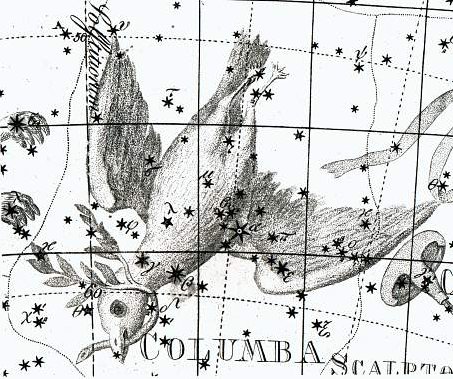|
4. The 8th star pillar is Betelgeuze, rising 17 days earlier than ω Gemini:
We could then expect the 9th, 'exit pillar', to be a star rising later than Betelgeuze but earlier than ω Gemini. However, γ Ursae Majoris is at the opposite side of the sky roof (measured by right ascension). Reflecting upon this peculiarity I suddenly had a sense of déja vu - I had been there before. Searching among my old pages for Ana-iva, it soon became clear. I once had made a mistake: Makemson (in her The Morning Star Rises) has written that the 9th Tahitian pillar is Phaet, but failing to find this name I had assumed she meant Phaed. Ursa Major is close to Ursa Minor so it seemed reasonable to believe Phaet was just another spelling of Phaed. Later I came to realize there indeed was a star named Phaet, viz. α Columbae, but I did not change what I had written before. This is the way I have to work - I cannot take time to correct earlier mistakes by changing what has been written, otherwise I would never be able to move ahead with the necessary speed. Anyhow, Makemson has written that the pillar of exit is α Columbae, a star for which I have used the name Phakt. The similarity in the names Phaet and Phaed is probably a Sign, the meaning of which we must leave until later, when we reach 12h. But already here we ought to let Allen inform us about the importance of Phaet: "Phaet, Phact, and Phad are all modern names for this, perhaps of uncertain derivation, but said to be from the Hadar already noted under the constellation. [Hadar was mentioned when discussing the meaning of Muliphein: '... comprehending the two stars called Had'ár, ground, and al-wezn, weight.'] The Chinese call it Chang Jin, the Old Folks. Although inconspicious, Lockyer thinks that it was of importance in Egyptian temple worship, and observed from Edfū and Philae as far back as 6400 B.C.; but that it was succeeded by Sirius about 3000 B.C., as α Ursa Majoris was by γ Draconis in the north."
Possibly the 3 'eyes' at left in Ga1-21 could indicate manu mata etoru is leaving - south of the equator a Moon crescent of this type means 'waning'. We remember the hidden hole through which first his mother and then Maui himself went down: ... Not far away he saw her stop and pull up a clump of rushes. There was a hole under it, which she dropped into. She pulled the rushes into place behind her, and was gone. Maui slipped out and ran as fast as he was able to the clump of rushes. He pulled it and it came away, and he felt a wind against his face as he looked through the hole. Looking down, he saw another world, with trees and the ocean, and fires burning, and men and women walking about ... |

